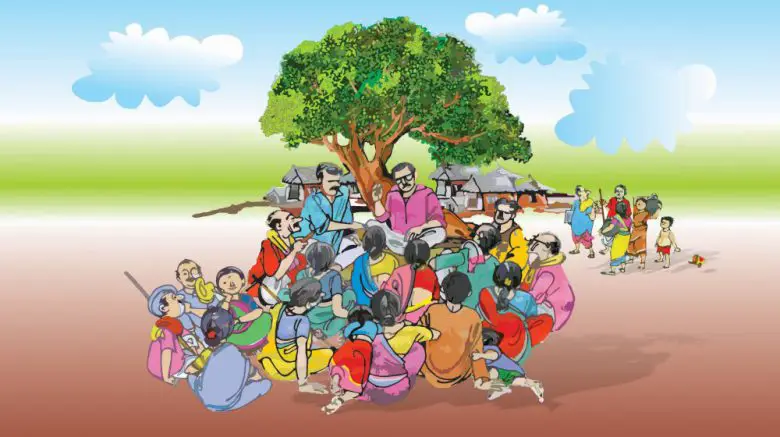Gram Nyayalaya and act of 2008 | UPSC – IAS
Gram Nyayalaya are established generally at headquarter of every Panchayat at intermediate level or a group of contiguous panchayat in a district where there is no panchayat at intermediate level. Gram Nyayalayas or village courts are established under the Gram Nyayalayas Act, 2008 for speedy and easy access to justice system in the rural areas of India.
Structure: It is established for every Panchayat at intermediate level or a group of contiguous Panchayats at intermediate level in a district.
- The State Government, in consultation with the High Court, notifies the boundaries of the area under the jurisdiction of a Gram Nyayalaya. It can also alter such limits at any time.
- It can hold mobile courts in villages falling under its jurisdiction and State Government shall extend all required facilities.
Appointments: The State Government shall appoint a presiding officer called Nyayadhikari for every Gram Nyayalaya in consultation with the High Court, who will be a person eligible to be appointed as a Judicial Magistrate of the First Class.
- The salary and other allowances along with the other terms and conditions of service shall be on the same lines as well.
- Representation shall be given to the members of the SC, ST, women and others.
Jurisdiction, powers and authority: Gram Nyayalaya shall exercise both civil and criminal jurisdiction. The judgment passed by a Gram Nyayalaya in civil cases shall be deemed to be a decree. Gram Nyayalaya can try:-
- Criminal cases,
- Civil suits,
Claims or disputes which are specified in the First and Second Schedules to the Act:-
- Offences not punishable with death, imprisonment for life or imprisonment for a term exceeding two years.
- Theft, matters regarding stolen property, where the value of the property stolen does not exceed rupees twenty thousand
- Offences related to central acts such as payment of wages, minimum wages, Protection of civil rights, bonded labour, Protection of Women from Domestic Violence Act, etc.
- Offences under states acts which are notified by each state government.
- Civil and Property suits such as use of common pasture, water channels, farms, right to draw water from a well or tube well etc.
- The first and second schedules of the Gram Nyayalaya Act can be amended by both the central and state governments.
A Gram Nyayalaya is not bound by the rules of evidence provided in the Indian Evidence Act, 1872 but is guided by the principles of natural justice and is subject to any rule made by the High Court.
- An appeal against a judgement of a criminal case shall be taken to the Court of Session, while a civil case appeal shall be taken to District court. Appeals have to be heard and disposed of within six months.
- The primary focus of the Gram Nyayalaya is to bring about conciliation between the parties. If any stage that there is a reasonable possibility of a settlement between the parties, the proceedings of Gram Nyayalaya shall be adjourned and the matter shall be referred to conciliator/s.
Ineffectiveness of Gram Nyayalaya
Concurrent jurisdiction with regular courts: Majority of states have set up regular courts at the taluk level instead of setting up Gram Nyayalayas, perhaps with a view to avoid the complexities involved in implementation of a new legislation, fresh appointment of Nyayadhikaris, and negligible funding from the central government.
- Shortage of human resources: The progress is affected by non-availability of judicial officers to function as Gram Nyayadhikaries, Non-availability of notaries, stamp vendors etc.
- Funds: The slow pace of utilisation of funds under the Scheme is mainly due to the lack of proposals from the States for setting up of Gram Nyayalayas.
- While some States were facing problem like inadequate amount of Central funds allocation and the acquisition of land for the establishment of Gram Nyayalayas.
- Reduction of Pendency: One of the objectives of the Act was to reduce pendency and burden on lower courts in the district but it is revealed that even this has not been fulfilled. The number of cases disposed by Gram Nyayalayas is negligible and they do not make any substantial difference in the overall pendency in the subordinate courts.
- Functioning: Gram Nyayalayas have been established on part-time basis (weekly once or twice) and are not in addition to the existing courts. However, it has been observed that in most villages, courts are held only once or twice a month while in others, the frequency is even worse, mostly due to the lack of coordination between High Courts and state governments.
- They have been grappling with systemic defects, lack of practice of recording case data and status, lack of political will etc.
- Lack of awareness: Many of the stakeholders including the litigants, lawyers, police officers and others are not even aware about the existence of Gram Nyayalayas in the district court premises and no conferences or seminars have been organized for creating awareness about this institution.
- Further, there is ambiguity and confusion regarding the specific jurisdiction of Gram Nyayalayas, due to the existence of alternative forums such as labour courts, family courts, etc.
A Way Forward | UPSC – IAS
- Establishment of permanent Gram Nyayalayas: They may be established in every Panchayats at intermediate level or group of contiguous Panchayats at intermediate level depending upon the number of disputes which normally arise from that area. While determining the location of the Gram Nyayalayas the location of courts having parallel jurisdiction may also be considered.
- Infrastructure and Security: Separate building for the functioning of the Gram Nyayalaya as well as for the accommodation of the Gram Nyayadhikaris and other staff need to be constructed. Provision also has to be made for providing adequate security.
- Enhancing of the Central assistance in order to motivate the States should also take place.
- As far the issue of acquiring land is concerned, the State Governments may be encouraged to undertake vertical constructions instead of horizontal to weed out the problem of shortage of land.
Creation of a regular cadre of Gram Nyayadhikari: Officers recruited to this service ought to have a degree in social work apart from a law degree.
- However, some of the Gram Nyayadhikaris opined that creation of such a separate cadre might not be advisable due to the absence of chances of promotion.
- Instead, this could be made a compulsory service for a certain period for a newly recruited judicial officer to the regular cadre of first class judicial magistrates or civil judges.
Training of Gram Nyayadhikari: This is imperative keeping in mind the objectives of Gram Nyayalayas. Apart from the legal and procedural requirements of Gram Nyayalayas, training may also include the local language of the community amongst whom they are posted.
Creation of awareness among various stakeholders: Suitable steps may be taken for creating awareness among various stakeholders including the revenue and police officers.
Gram Nyayalayas Act, 2008 | UPSC – IAS
Gram Nyayalayas Act, 2008 is an Act of Parliament of India enacted for establishment of Gram Nyayalayas or village courts for speedy and easy access to justice system in the rural areas of India.
Features of Gram Nyayalayas Act, 2008 | UPSC – IAS
- Gram Nyayalaya are established generally at headquarter of every Panchayat at intermediate level or a group of contiguous panchayat in a district where there is no panchayat at intermediate level.
- The Gram Nyayalayas are presided over by a Nyayadhikari, who will have the same power, enjoy same salary and benefits of a Judicial Magistrate of First Class. Such Nyayadhikari are to be appointed by the State Government in consultation with the respective High Court.
- A Gram Nyayalaya have jurisdiction over an area specified by a notification by the State Government in consultation with the respective High Court. The Court can function as a mobile court at any place within the jurisdiction of such Gram Nyayalaya, after giving wide publicity to that regards.
- The Gram Nyayalayas have both civil and criminal jurisdiction over the offences and nature of suits specified in the First, Second and Third schedule of the Act. The pecuniary jurisdiction of the Nyayalayas are fixed by the respective High Courts.
- The fees charged in civil suits shall not exceed Rs.100 irrespective of the value of property in dispute.
- Both the Central and the State Government can add or remove items in the Schedule. While the Central Government can amend the list in Schedule I and II, by notifying them and thereafter laying it in the Parliament, the State Government can amend the items in Part III of Schedule I or II, in the areas of law which the state is competent to enact law after due consultation with the respective High Court and notifying it. Such notification has to be laid in the State Legislature.
- Offences are to be tried in a summary manner in accordance with Chapter XXI of Code of Criminal Procedure.
- The Act allows plea bargaining in accordance with Chapter XXIA of Code of Criminal Procedure.
- Gram Nyayalayas can follow special procedures in civil matters, in a manner it deem just and reasonable in the interest of justice.
- Civil suits are proceeded on a day-to-day basis, with limited adjournments and are to be disposed of within a period of six months from the date of institution of the suit.
- In execution of a decree, the Court can allow special procedures following rules of natural justice.
- Gram Nyayalayas allow for conciliation of the dispute and settlement of the same in the first instance.
- Gram Nyayalayas has been given power to accept certain evidences which would otherwise not be acceptable under Indian Evidence Act.
- Appeals in criminal matter can be made to the Sessions Court in the respective jurisdiction and in civil matters to the District Court within a period of one month from the date of judgment.




